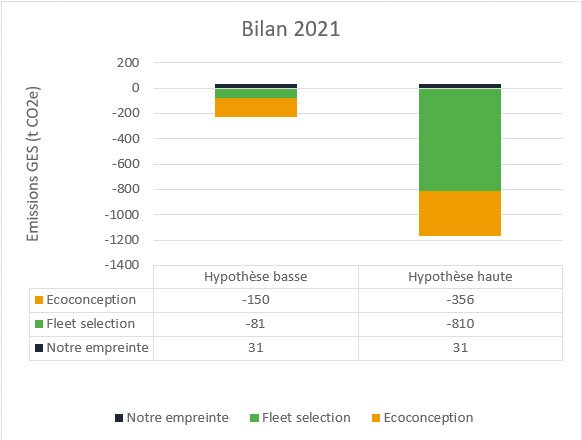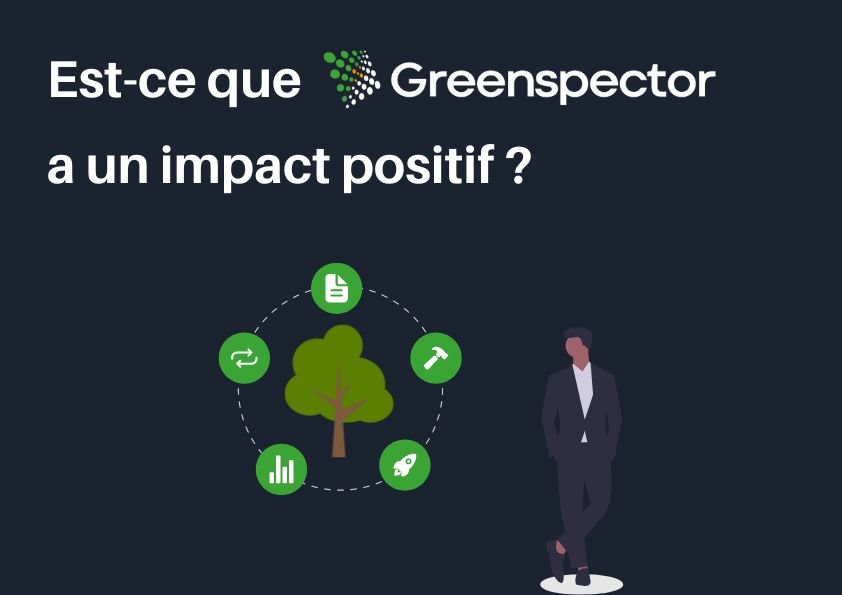At Greenspector, our mission is to help our customers reduce the environmental impact of their digital services. We work on this every day, but is it enough to offset our own impacts?
To this fundamental question, we must admit that we do not have a simple answer at this time. We will propose to our Mission Committee to work on this subject in order to go further. In the meantime, here is what we can share with you.
To verify that we are having a positive impact, we need to know our own impacts, and estimate the impacts that our clients are avoiding thanks to us. For this exercise, we will focus on the most easily assessable impact data: greenhouse gas emissions.
Our impacts
This is the “easy” part of the calculation. We have been doing our carbon footprint every year since 2019, using the excellent software from our friends at Toovalu. So we know our greenhouse gas emissions. In 2021, they were 31 tCO2e.
Is this a lot? We can reduce this value to a monetary ratio commonly used in this type of approach: 31 tCO2e for 851 k€ of turnover in 2021, which represents 36.9 kgCO2e/k€ of turnover. By way of comparison, ADEME indicates an average value of 110 kgCO2e/k€ for the category “low material services”. We are therefore 66% below the sector average. This is good, but we can certainly do better.
Avoided impacts
This is where things get complicated. On the one hand, our activities are diverse (sales of licenses, audits of mobile applications or websites, help in choosing Android fleets, etc.). On the other hand, it is not so easy to know how much we have helped to avoid. We need to be able to measure “before” and “after” (which does not always happen) and ideally, between “before” and “after”, only our recommendations to reduce impacts should have been applied. However, if you develop applications or websites, you know that between two versions, it is rare that there are not multiple changes of all kinds.
Finally, there is a methodological question: let’s suppose an audit on a version 1.0, which leads to 30% less impact on a version 1.1. Can we consider that this 30% will be avoided ad vitam aeternam, in other words, can we consider that version 1.7, which will be released in 18 months, will have 30% less impact than 1.7 would have had if we had not intervened on version 1.0? For want of a better answer, we have chosen to consider that the avoided impacts apply for the next 12 months.
So we do not have the possibility of calculating avoided impacts on all our projects or for all our clients – which we regret. However, we can get an idea from a few cases for which this calculation was possible.
Let’s take three examples:
- The SNCF Connect mobile application (Android version): we were able to determine the impact avoided on the TER ticket reservation process: -18.9% or -10 tCO2e over one year.
- At the opposite extreme, the Orange Group’s Integrated Annual Report (IAR): the RAI 2021 website has a 55% lower impact than the RAI 2020, which for its audience – modest for this type of content – represents an avoidance of 0.024 tCO2e over one year.
Here we have 2 projects typical of our activity, extreme in their audiences, accumulating 10 tCO2e avoided, so an average of 5 tCO2e per project. However, in 2021 we worked on more than 70 application or website projects. By taking the average of these two projects, multiplied by 70 projects, we arrive at 356 tCO2e avoided. Another approach based on a categorisation of each service according to its intensity of use gives us 150 tCO2e. Let us retain this lowest value.
As a reminder, our own footprint that year was 31 tCO2e: even if our low value of 150t was still overestimated, it would be very surprising if it turned out to be less than 31t.
“And the third example?”, say those who follow
The third example is a lesser known service in our catalogue. This is our “Fleet Selection” offer, which consists, thanks to our laboratory measurements, of assisting our customers in choosing a smartphone for their business mobile fleet. The measurements and recommendations focus on autonomy criteria, of course, but also on the durability of the terminals (battery life, robustness, etc.) in order to check that they will be able to meet business needs for as long as possible.
In 2021, we helped a client choose the most sustainable device for a fleet of 35,000 smartphones and 5,000 tablets. Thanks to our measurements, he was able to ensure that he chose a model with an expected lifespan of 4 years instead of 3. The manufacturing impact of a smartphone is on average 54 kg CO2e, that of a tablet 108 kgCO2e (values extracted from the Greenspector impact model). Extending this fleet by one year before replacement therefore represents a saving of 810 tCO2e. It can be argued that we are not 100% responsible for this choice. If we attribute even 10% of these 810t to ourselves, this represents 81 tCO2e avoided – compared to the 31t we emit.
Conclusion
We don’t yet know how to quantify our positive impact precisely, and we may never know. But it is important for us to make sure that we do have a positive impact. This 2021 exercise has demonstrated that.
We will continue to work on this assessment of avoided impacts in order to arrive at more accurate results in the future. But even under conservative assumptions, we are confident that our actions are saving greenhouse gas emissions.

In addition, it should be remembered that improving the sobriety of apps has other positive impacts, particularly on the social aspect by enabling people with old and/or low-end terminals to access these digital services that are often indispensable in daily life.
All this makes us proud and strengthens us to continue our mission.

